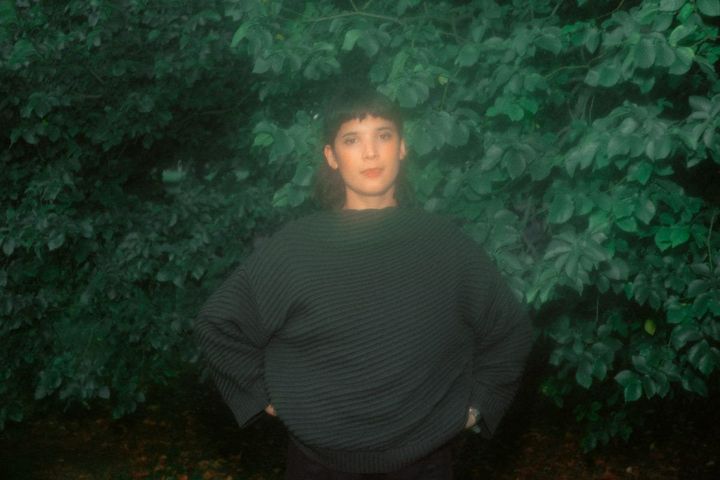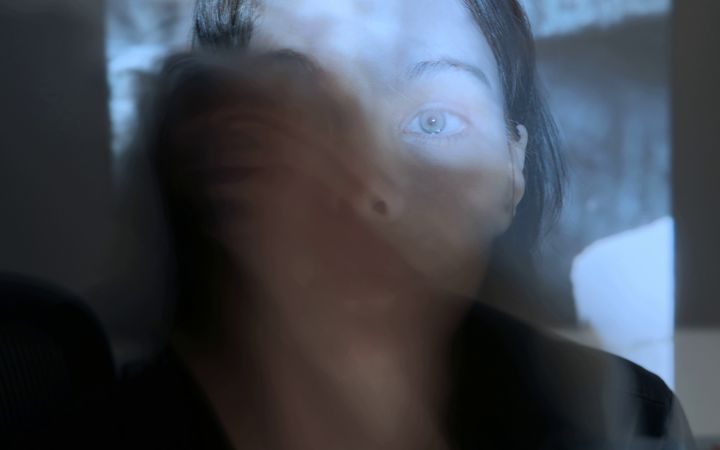Interview: Haco

There’s a point in this interview where Japanese artist Haco refers to her voice as being “see through” and “like mist”, which is perfect. In fact, the whole of Qoosui is driven by this tentative adherence to form, pouring guitars into basins of field recording and evaporated electronics, speculating about what the shapes might mean as they swirl in and out of possibility. There are no hard and irrefutable surfaces, and throughout Haco’s dream-led ventures into space and sun and snow, reality never comes to curb the fantastical forms of what might be. In fact, the album’s two music videos encapsulate the imagery of Qoosui better than my written accounts ever could: firstly through Masakazu’s Fukuta’s vaporous video for “Tidal”, and again via Tomáš Knoflíček’s synaesthesic illumination of “Shooting Stars In Your Eyes”
Below, Haco and I discuss nature, the universe and the various collaborations that brought Qoosui into being.
This record feels like a drastic change from your last album, Secret Garden. When did you start to compose Qoosui? Was there anything in particular that led you toward such a different sound on this new one?
I had a small launch tour for the album Secret Garden in the western Japan (after my European tour) in November, 2015. Luckily, Stabilo and Gallery Six organized an event for my show in Hiroshima, and then I discovered their music. They had run a series of digital split EPs that came out every two months, and I fell in love with their ambient, electronic drone. It was the most suitable music for when I spent lots of time emailing and doing clerical work on my laptop. And potentially I felt that I may make new songs on some of their tracks, and it was the staring point to collaborate with them.
My experience of this record has been so enriched by reading the lyrics to these pieces. Several of them seem to centre on experiences of being extremely present amidst nature or imagined spaces, turning the mind to the sensations and sounds (and mysteries, perhaps?) of the surrounding space. Could you tell me about the places you visit, through lyrics and sound, on Qoosui? Are they all imaginary, or are any of them influenced by real spaces and experiences?
There are places to find a deep forest, ocean tide, satellite, snowy alley, rippling waves, green grass etc on Qoosui. The original sound materials had some specific mood engaged in nature and the universe, and it made me blow up their image. My lyrics are gently superimposed on imaginary scenes from them. The Japanese words of “Kusui” and “Seiren” were written by Hidekazu Imashige who lives in the countryside in Hiroshima; he visited the real mountains and the seaside for the first lyrics he’d written in his life. I wrote “Shooting Stars in Your Eyes” just after my last European tour, in October 2016, and it includes one of my experiences: a phenomenal moment through the eyes of someone.
I’d love to ask about the various collaborators you worked with on Qoosui, which include Hidekazu Imashige (aka Gallery Six), Jara Tarnovski (Gurun Gurun) and Yasutica Horibe (Stabilo). One of the most remarkable aspects of Qoosui is how elegantly these tracks run into eachother – with a fluid, narrative inevitability – even though it’s woven together from the contributions of various individuals from around the world. How much conversation took place between you and the collaborators, regarding the atmospheres or sensations you wanted to bring into being?
We didn’t need so much conversation for the composition. My lovely collaborators just sent me their separate tracks and materials, and they very much inspired me to make my vocal parts and other arrangements by using a sampler and so on. As for Jara, we had a lot of conversation about the post production, when I struggled about some parts of the final mix. I let him listen to it and asked for his opinion, and it was really helpful for me. And his band mate, Ondřej Ježek (Gurun Gurun), is an excellent mastering engineer – we worked very hard together (between Prague and Kobe) on the final stage of the record, and are absolutely happy about the resultant sound.
Your voice throughout this album is such a wonderful presence. I love the way that it rises out of the music and then slips back inside it, like a whale momentarily arcing above the ocean surface. Sometimes it appears to be woven into the fabric of the music; at other points it feels separate from it, like a curious visitor passing through. I feel as though the “ego” that resides within the voice is forever thickening and evaporating. How do you think about the role of the voice within your music? Has this changed since your last record?
I love your account: “like a whale momentarily arcing above the ocean surface”. Very poetic!
Whispering voice was already in my previous albums, yet, especially on Qoosui, I wanted to take a super ethereal approach with the voice, which is pretty much layered. As if a singer is there, yet see-through within the large landscape, like mist.
The track “Anesthesia Love” caught me by surprise. Whereas the lyrics of the other pieces centre more on external stimuli and interactions with the world outside, this track feels more internally and emotionally driven. This also feels apparent in how the soundscape bursts outward from a single point (the guitar), rather than being evenly dispersed across various points in space and various sound sources. Could you tell me about how this song came into being? Is there anything unique about how this song was written compared to the rest?
Firstly, I wanted to have a surprise track on this record. Secondly, I’m a big fan of the Japanese post-rock/shoegaze band, Speaker Gain Teardrop, and Yasutica Horibe (aka. Stabilo) is actually also a guitar player in the band. He provided me with some his original guitar materials, and I sampled them to play with my fingers. This composition was about letting the door of my imagination burst open to the next dimension – something “bloody”, becoming a metaphor for the words.
Are there specific locations, times of day or states of mind that you find to be most conducive to the experience of composing your music?
Mostly I compose and record from evening to midnight, since I like that my neighborhood gets quieter and then goes off to sleep. Then I can better concentrate on getting into my world.
The positioning of each sound within Qoosui feels so exact. Every instrument is placed with such care. How long did you spend mixing this record, and how did you find the experience?
This time I roughly mixed each song one by one, and it took less than a month for the final mix and adjustments. Personally I like to work on the mix for just a few hours a day, and then listen to it the next day with fresh ears. There were plenty of voice tracks that fit like a puzzle, and I placed them like a mosaic with other instruments. Stabilo and Tarnovsky’s sub-mixes on their separate tracks were almost perfect, and I didn’t touch them so much for the final mix.
So far, my listening experiences with Qoosui have all taken place at home, although this feels like a record that I want to take walking with me. Does this record have an ideal listening environment for you? Are there any particular places you go to when you want to listen to an album intently?
I’m so glad if you take walks with Qoosui. Any environment with a situation such as driving, meditating, drinking, emailing, and wherever would be fine for this record. For me, sometimes I want to listen to it before sleeping, after work.
Masakazu Fukuta’s artwork for Qoosui is beautiful, and harmonises perfectly with the imagery that comes to me when I listen to this record (the same is true of his video for “Tidal”). How did you find the experience of collaborating with him for the visual component of Qoosui?
When my recording of the Qoosui has been done 80%, I was looking for a completely suitable image for the cover art of this album. It should be something ambient, layered, feminine, and airy. At the same time, I was sent the information about the Masakazu Fukuta exhibit by the mail magazine from the Third Gallery Aya in Osaka, where I used to know. As soon as I saw the picture of the piece “Jewel”, I immediately thought that I have to meet this gifted young artist, and actually went to the gallery and started to talk with him about my album that I had been working on.
You will soon be embarking on a tour across Japan. How easy has it been to transpose the tracks on Qoosui into pieces that can be performed live?
I used a soft sampler with the sound application on the recording, so it’s easy to re-program playing the samples with my fingers on the computer keyboard of my laptop, and combine other parts to transpose. And the new video images that I collaborated on with my old friend, Mariko Tajiri, will be accompanying my performance. And of course, I will be singing and controlling the voice effects by myself and sampling my voice in real time.
What else is coming up in the future?
An album and full-length video of improvised collaborations with the wonderful New Zealand composer/sound artists from Wintec (School of Media Arts Waikato Institute of Technology) will be released in December. And a couple of collaborative recording projects with the German electronic artist, Stefan Schneider, and with the Czech electro-acoustic quartet, Gurun Gurun are in progress.
Actually, I’m really hoping to do the Qoosui tour in Europe in 2018, and looking for some possibilities for it! Thank you very much.




